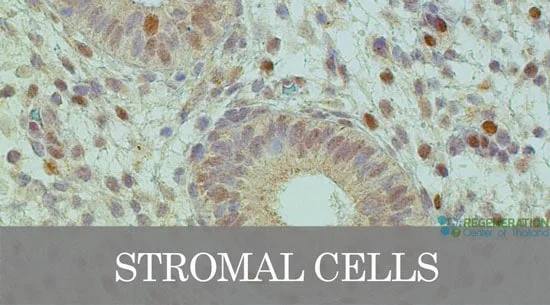
Stromal cells are the connective tissue cells for all organs in the human body. The most common types these cells in our bodies are Pericytes and Fibroblasts (skin cells)
Stromal cells can be found in:
The primary function of the stromal cells are to support functions of the parenchymal cells of the specific organ in which they are found.[1] Widely used today in regenerative medicine centers are MSCs cells or Mesenchymal stem cells which are essentially multipotent stromal cells and used in many stem cell therapies including spinal cord injuries and burst fractures in the cervical and lumbar spine. [2] Stromal cells posses broad immunoregulatory properties.
Stromal cells are a diverse group of connective tissue cells that provide structural support to the organs in which they reside. Unlike the functional cells of a tissue (often referred to as the parenchymal cells), stromal cells mainly serve supportive, architectural, and nutritive functions. They are a critical component of the tissue microenvironment and are particularly important in the context of stem cell niches and immune cell function.
Stromal cells can be classified based on the tissue or organ where they are found. Some common types include:
Stromal cells are becoming increasingly significant in various medical applications:
While stromal cells hold immense therapeutic potential, especially in the fields of regenerative medicine and oncology, further research is needed to fully understand their complex roles in different tissues and pathological conditions. Stromal cells are unique in cancer research also. The general interaction between cancerous tumor cells and stromal cells is what is believed to play a significant role in cancer growth and development.[3]
Fibroblast Stromal cells in the epidermis (outer) layer of our skin constantly releases immuno growth factors that help promote cell division that keeps our skin healthy and fresh. Certain skin cancers such as basal cell carcinoma cannot spread throughout the body because the cancer cells require nearby stromal cells beyond the skin areas to continue its constant division. By removing these stromal cell growth factors in certain instances we can prevent some cancers from spreading themselves to other vital organs. Stromal cells serve as the “soil” in which the “seeds” of functional cells in tissues grow and thrive. Their supportive role extends not just to structural integrity but also to the regulation of crucial biological processes. Understanding the various functions of stromal cells could greatly advance our approaches to tissue engineering, regenerative medicine, and cancer therapy.
To learn more or if you have any other questions please contact us today.
[1] ^ Anna-Maaria Vähä, Anniina Veijola, Henna Karvonen, Siri Lehtonen, Riitta Kaarteenaho, P053 Variable effect of pirfenidone, nintedanib and N-acetylcysteine solely and combined on stromal cells of different types of pulmonary fibroses , QJM: An International Journal of Medicine, Volume 109, Issue suppl_1, September 2016, Page S39, https://doi.org/10.1093/qjmed/hcw124.025
[2] ^ Karen English, Mesenchymal stromal cell therapy for pulmonary fibrosis , QJM: An International Journal of Medicine, Volume 109, Issue suppl_1, September 2016, Page S30, https://doi.org/10.1093/qjmed/hcw119.030
[3] ^ J. Stolk, W. Broekman, T. Mauad, J.J. Zwaginga, H. Roelofs, W.E. Fibbe, J. Oostendorp, I. Bajema, M.I.M. Versteegh, C. Taube, P.S. Hiemstra, A phase I study for intravenous autologous mesenchymal stromal cell administration to patients with severe emphysema, QJM: An International Journal of Medicine, Volume 109, Issue 5, May 2016, Pages 331–336, https://doi.org/10.1093/qjmed/hcw001
If you've seen people take ice baths or cold showers and wondered if they're onto… Read More
Immunomodulation stands at the forefront of biomedical research, steering the immune system's ability to fight… Read More
Stem cell research leads the charge in medical innovation, heralding revolutionary advances in regenerative medicine.… Read More
The blood-brain barrier (BBB) is a crucial shield for the brain, regulating the entry of… Read More
While peptide bonds are fundamental to protein structure, their direct relationship with stem cells lies… Read More
When discussing cutting-edge cancer treatments, NK cell therapy stands out due to its unique approach… Read More